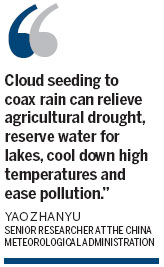China aiming to tame weather
Updated: 2013-09-05 07:38
By Wang Qian (China Daily)
|
||||||||
National plan considered to enhance coordination
Man can conquer nature, so goes an ancient Chinese saying that highlights human power.
In a move appearing to support that saying, China plans to boost its weather intervention through a national plan.
The plan, running from 2013 to 2020, will divide the country into six regions and set up an interprovincial mechanism for weather control, Yao Zhanyu, a senior researcher of the Weather Modification Center under the China Meteorological Administration, told China Daily.
Each region will build infrastructure and a command center for weather intervention, according to Yao.
Programs in northeastern, central and southeastern areas will be used mainly to guarantee the wheat harvest, and the northwestern program will be for environmental protection, Yao said.
He added that the southwestern program will focus on ensuring the operation of agriculture and hydropower, while the northern program will be concerned with guaranteeing water supplies.

China modifies weather mainly to increase rain or snow and prevent damaging weather such as hail, fog and rainstorms. Cloud seeding is the major weather modification activity in China.
According to Yao, the northeastern region - covering Liaoning, Jilin and Heilongjiang provinces and parts of the Inner Mongolia autonomous region - was selected as a pilot area to test the coordination system after the National Development and Reform Commission approved a feasibility report in May 2012.
The report said the project will invest nearly 1.1 billion yuan ($177 million) by 2014 to build a regional weather intervention system in northeastern China, including 12 weather intervention airplanes and ground-based facilities.
Yao said a feasibility report for the northwest started recently and the program is expected to be launched within one year if everything goes well.
The northwestern area, including Gansu province, the Ningxia Hui autonomous region, the Xinjiang Uygur autonomous region and parts of Inner Mongolia, is the main source of the sandstorms in spring and autumn.
To better meet agricultural demand and relieve disasters, China plans to increase annual precipitation by 60 billion metric tons and extend the coverage of artificial hail suppression to more than 540,000 square kilometers by 2020, according to the State Council.
"Cloud seeding to coax rain can relieve agricultural drought, reserve water for lakes, cool down high temperatures and ease pollution," Yao said.
However, as cloud seeding is used on a massive scale, some critics have questioned whether there is an environmental impact as a result of manipulating the weather.
China commonly uses silver iodide, a hazardous substance and a toxic pollutant, for cloud seeding.
The country has used silver iodide to lessen the impact of periodic droughts since 1958.
But Lei Hengchi, a scientist specializing in weather intervention, said little impact would occur because the amount of chemicals in cloud seeding is too small compared with the size of the affected region.
Cloud-seeding aircraft use 200 grams to 300 grams of silver iodide during a flight. A rain-enhancement shell contains only 1 gram of silver iodide, while a rocket contains about 8 to 15 grams.
wangqian@chinadaily.com.cn
(China Daily USA 09/05/2013 page3)
Most Viewed
Editor's Picks

|

|

|

|

|

|
Today's Top News
Smithfield deal still in question
US faces substantial losses if Egypt aid halted
Bank of America finally exits CCB
US divided as Obama presses for Syria attack
Xi, Putin meeting to focus on 'mega projects'
Writers sue Apple for compensation
S. Korea a model for innovation: experts
Why China dominates solar panels
US Weekly

|

|













